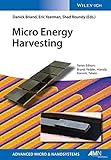Micro energy harvesting / edited by Danick Briand, Eric Yeatman and Shad Roundy.
Series: Advanced micro & nanosystemsPublisher: Weinheim : Wiley-VCH Verlag GmbH & Co. KGaA, [2015]Description: 1 online resource : illustrations (mostly color)Content type:- text
- computer
- online resource
- 9783527672936
- 3527672931
- 9783527672929
- 3527672923
- 9783527672912
- 3527672915
- 9783527672943
- 352767294X
- 3527319026
- 9783527319022
- 621.31/24 23
- TK2897
Includes bibliographical references and index.
Cover; Title Page; Copyright; Contents; About the Volume Editors; List of Contributors; Chapter 1 Introduction to Micro Energy Harvesting; 1.1 Introduction to the Topic; 1.2 Current Status and Trends; 1.3 Book Content and Structure; Chapter 2 Fundamentals of Mechanics and Dynamics; 2.1 Introduction; 2.2 Strategies for Micro Vibration Energy Harvesting; 2.2.1 Piezoelectric; 2.2.2 Electromagnetic; 2.2.3 Electrostatic; 2.2.4 From Macro to Micro to Nano; 2.3 Dynamical Models for Vibration Energy Harvesters; 2.3.1 Stochastic Character of Ambient Vibrations
2.3.2 Linear Case 1: Piezoelectric Cantilever Generator2.3.3 Linear Case 2: Electromagnetic Generator; 2.3.4 Transfer Function; 2.4 Beyond Linear Micro-Vibration Harvesting; 2.4.1 Frequency Tuning; 2.4.2 Multimodal Harvesting; 2.4.3 Up-Conversion Techniques; 2.5 Nonlinear Micro-Vibration Energy Harvesting; 2.5.1 Bistable Oscillators: Cantilever; 2.5.2 Bistable Oscillators: Buckled Beam; 2.5.3 Monostable Oscillators; 2.6 Conclusions; Acknowledgments; References; Chapter 3 Electromechanical Transducers; 3.1 Introduction; 3.2 Electromagnetic Transducers; 3.2.1 Basic Principle
3.2.1.1 Induced Voltage3.2.1.2 Self-Induction; 3.2.1.3 Mechanical Aspect; 3.2.2 Typical Architectures; 3.2.2.1 Case Study; 3.2.2.2 General Case; 3.2.3 Energy Extraction Cycle; 3.2.3.1 Resistive Cycle; 3.2.3.2 Self-Inductance Cancelation; 3.2.3.3 Cycle with Rectification; 3.2.3.4 Active Cycle; 3.2.4 Figures of Merit and Limitations; 3.3 Piezoelectric Transducers; 3.3.1 Basic Principles and Constitutive Equations; 3.3.1.1 Physical Origin of Piezoelectricity in Ceramics and Crystals; 3.3.1.2 Constitutive Equations; 3.3.2 Typical Architectures for Energy Harvesting; 3.3.2.1 Modeling
3.3.2.2 Application to Typical Configurations3.3.3 Energy Extraction Cycles; 3.3.3.1 Resistive Cycles; 3.3.3.2 Cycles with Rectification; 3.3.3.3 Active Cycles; 3.3.3.4 Comparison; 3.3.4 Maximal Power Density and Figure of Merit; 3.4 Electrostatic Transducers; 3.4.1 Basic Principles; 3.4.1.1 Gauss's Law; 3.4.1.2 Capacitance C0; 3.4.1.3 Electric Potential; 3.4.1.4 Energy; 3.4.1.5 Force; 3.4.2 Design Parameters for a Capacitor; 3.4.2.1 Architecture; 3.4.2.2 Dielectric; 3.4.3 Energy Extraction Cycles; 3.4.3.1 Charge-Constrained Cycle; 3.4.3.2 Voltage-Constrained Cycle; 3.4.3.3 Electret Cycle
3.4.4 Limits3.4.4.1 Parasitic Capacitors; 3.4.4.2 Breakdown Voltage; 3.4.4.3 Pull-In Force; 3.5 Other Electromechanical Transduction Principles; 3.5.1 Electrostrictive Materials; 3.5.1.1 Physical Origin and Constitutive Equations; 3.5.1.2 Energy Harvesting Strategies; 3.5.2 Magnetostrictive Materials; 3.5.2.1 Physical Origin; 3.5.2.2 Constitutive Equations; 3.6 Effect of the Vibration Energy Harvester Mechanical Structure; 3.7 Summary; References; Chapter 4 Thermal Fundamentals; 4.1 Introduction; 4.2 Fundamentals of Thermoelectric Power Generation
With its inclusion of the fundamentals, systems and applications, this reference provides readers with the basics of micro energy conversion along with expert knowledge on system electronics and real-life microdevices. The authors address different aspects of energy harvesting at the micro scale with a focus on miniaturized and microfabricated devices. Along the way they provide an overview of the field by compiling knowledge on the design, materials development, device realization and aspects of system integration, covering emerging technologies, as well as applications in power management, e.
Online resource; title from PDF title page (Ebsco, viewed May 1, 2015).
There are no comments on this title.

